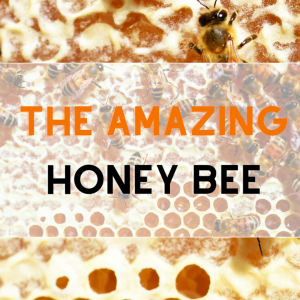The Amazing Honey Bee
By Vivienne Couris, C2ST Intern, DePaul University
Spring has officially sprung! The sun is sticking around for longer, the trees are blooming, and the birds are singing all morning long. As you begin to venture outside to enjoy the warmth, you may stumble across a rather unassuming little insect. She’s easygoing and loves flowers, and she’s famous for her one-of-a-kind recipe. If you guessed honeybee, you’re correct! In this blog, we’ll discuss the impressive biology of the honeybee, and how they have become an integral part of human agriculture.

Honey bees are small, flying insects that are found throughout the US. They are one of the most valuable resources to human agriculture, and they display a fascinating way of living. Honey bees live in large, interconnected communities called colonies. Colonies include tens of thousands of individual bees, including the single “queen”, a few hundred drones (male bees), and thousands of female worker bees.
To begin this breakdown, we’ll first note that honey bees are not native to North America. Instead, they were brought overseas about 400 years ago by early European settlers for agricultural purposes. Honey bees are therefore considered domesticated, where bee populations that aren’t controlled by people are classified as feral rather than wild. Most US honey bees reside in artificial hives and are managed as any other farm animal. That being said, you may still see them out and about, as they will travel as far as five miles from their hive in search of food!
Worker honey bees maintain their energy primarily by sipping nectar: a sweet, syrupy substance produced by flowers. They also bring nectar back to their hive to feed other worker bees. Another energy source for honey bees is pollen, a powdery substance that plants use for reproduction. Honey bees will store pollen in their “pollen baskets”, which are attached to either one of their hind legs and resemble the appearance of saddlebags. As they travel from flower to flower, some of the pollen will rub off the bee, pollinating the flower. In other words, the bee becomes a critical part of the flower’s reproductive process! The pollen that doesn’t get distributed to nearby flowers will be eaten by the bee as a vital protein source.
Another food source for the honey bee is perhaps the most famous: honey! Honey is a thick, sweet substance used as both a backup food source for seasons when flowers are not in bloom, and as insulation from the cold. Honey is basically nectar that has been dehydrated and concentrated. Nectar is passed among worker bees inside the hive by mouth, which begins the dehydration process. It is then inserted into honeycomb cells where it is further dehydrated by the air produced from the fanning of the bees’ wings. Once the honey has reached about 20% water content (as opposed to the original 80% in nectar), the honeycomb cell is sealed by a secretion called beeswax, thus completing the honey-making process.
We know why honey bees like honey, but many of us like it too! Humans have been eating honey for thousands of years, thanks to its sweet taste and nutritional and medicinal value. Fortunately, honey bees almost always produce more honey than the colony needs, so harvesting honey for human consumption does not harm the bees. Every year in the US, more than 125 million pounds of honey are harvested for sale. Beekeepers can manipulate the taste of their honey by placing their bees near certain species of flower; for example, bees placed near orange or lemon blossoms will produce honey that tastes citrusy.
Besides the honey we can get from bees, their pollination habits have also proven incredibly beneficial to US agriculture. As mentioned earlier, bees are responsible for increased reproduction rates in the plants they pollinate. Bees can pollinate upwards of $15 billion worth of US crops per year! It’s quite possible that they were involved in the growth of the produce in your home at some point.
Overall, honey bees are fascinating creatures that play an integral part of our lives. They make honey for us to eat, wax for us to use, and help us to cultivate our crops. You may have seen them buzzing around flowers, or maybe you’ve seen the stacked wooden boxes where they are kept. Wherever you find them, take a moment to appreciate all that they do!
References
- https://www.usda.gov/peoples-garden/pollinators/honey-bees#:~:text=They%20also%20produce%20delicious%20honey,fruits%2C%20nuts%2C%20and%20vegetables.
- https://scientificbeekeeping.com/whats-happening-to-the-bees-part-5-is-there-a-difference-between-domesticated-and-feral-bees/#:~:text=Yes%2C%20most%20managed%20breeds%20of,breeders%20rather%20than%20by%20nature.
- https://www.ncbi.nlm.nih.gov/pmc/articles/PMC3433997/
- https://www.perfectbee.com/learn-about-bees/the-life-of-bees/inside-and-out-of-the-beehive
- https://www.bbka.org.uk/how-far-does-a-bee-fly-how-does-it-navigate
- https://www.honeyflow.com/blogs/beekeeping-basics/how-do-bees-make-honey
- https://www.ncbi.nlm.nih.gov/pmc/articles/PMC3583289/#:~:text=Nutritional%20profile,%2C%20and%20micronutrients%20%5B2%5D.
- https://www.beeculture.com/u-s-honey-industry-report-2022/#:~:text=Honey%20Into%20the%20U.S.%2C%202022,production%20of%20133.3%20million%20pounds.